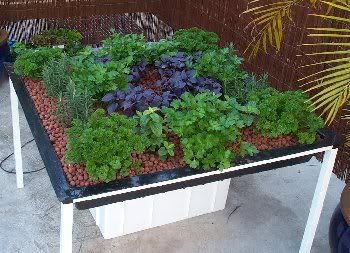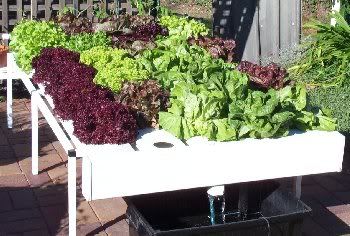HYDROPONIC SYSTEMS
An outline of the basic system types
FLOOD & DRAIN Flood & drain systems are one of the most advanced and user friendly media based growing systems in hydroponics. Flood & drain is being used more and more by commercial flower growers and has now been adapted for use in the home, as they provide optimum rootzone system exchange of nutrient, water and oxygen for maximum growth and productivity. Flood systems are ideal for both short and especially long term crops.
THE METHODFlood and drain uses two cycles to feed oxygen and nutrients to the roots. These are the flood cycle, and the drain cycle.FLOOD CYCLE: To get high oxygen levels to the root zone, first flood the root zone with nutrients, and expel all "dead air" from around the roots. DRAIN CYCLE: After the flood cycle (2-15 mins), drain the nutrients quickly to draw or 'suck' fresh oxygen into the root zone as the nutrients drain out and at the same time, leave the roots damp with nutrient. (15-45 mins). This feature of flood and drain systems makes it especially easy to obtain excellent results; it is also excellent for striking cuttings and clones.
THE DESIGNA flood and drain system is designed with a pump to move nutrient from a reservoir into the growing container or tray with the pump usually at the lowest point. The overflow is the drain point during the flood cycle. This ensures the growing container does not overflow with nutrients.While the pump is on nutrient is kept 'up' in the container. Nutrient flows in and fills all the spaces between the expanded clay and soaks the roots. Note that the nutrients are never still during this cycle, but are flowing up and out through the overflow. Dissolved oxygen levels in the nutrient are high because the nutrients cannot stagnate,and this is critically important for the plant's growth. During the drain cycle the pump switches off, and gravity forces the nutrients back through the pump into the reservoir. There is a filter to stop any damaging particles getting into the pump. As gravity drains the nutrient, the spaces between the expanded clay are left empty, and air rushes into the spaces left by the receding nutrient. The flood cycle should only be as long as it takes to fill the growing container or tray, and the drain cycle should be at least twice what it takes to drain the container. Usually 15 minutes on and 45 minutes off is enough. If any root problems occur, lengthen the drain cycle. During the night hours only have one flood cycle in the night, and one just before dawn. If heat is necessary, flood as normal during the night, but have one longer drain cycle during the morning and one in the afternoon to add extra oxygen.
NUTRIENT FILM TECHNIQUE (NFT) This technique was invented by Dr. Allan Cooper in England during the 1970's. His motivation was to save the British Glasshouse industry from cheaper European imported vegetables. The system had to be inexpensive to produce crops, and inexpensive to setup. Ideally the nutrient should be the only cost for running (except for the minimal pump power required) and there should be minimal need for cleaning and low labour costs. NFT proved to be one of the best, and still remains the system of choice for most commercial hydroponic cultivation. The N.F.T (Nutrient Film Technique) is based principally on a series of channels that provide constant flowing water, oxygen and minerals to the plant. This flow has a depth of 1mm so it's not a stream, rather more like a film of nutrient and water solution that supplies the plant. Nutrient film technique provides oxygen rich water and mineral salts, giving the plants everything required 24 hours a day which enhances growth and produces healthy, fast growing crops. In order to have the roots in contact with the nutrient, the solution is pumped from a tank up to the feed-line and injected into the ends of the gully via micro tubes, two to each gully. The reason for this is that in the event of one blocking, the plants' will still receive some flow of solution. Once inside the gully the nutrient solution moves slowly along the channel and the plants pick it up through capillary action. Upon reaching the end of the gully the solution is collected in a drain box and returned back to the tank to be recirculated back to the plants. With N.F.T systems it is very important to check nutrient and ph levels regularly. This can be done by an electronic meter which does both functions, or alternatively nutrient solution can be replaced on a weekly basis. Flow rates in N.F.T systems are usually 750ml to 1 litre per minute with the slope of 1:40 (1:40 = 25mm drop every metre). To check this, take a one or two litre measuring jug, take the two micro tubes out of the gully and start filling the jug, and it should take one minute to fill to the one litre mark on the jug. Adjustments can be made at the bypass tap at the pump, opening will reduce pressure and closing will increase pressure. The bypass water will also help oxygenate the nutrient solution. Gully size is largely dependant on what crop is grown and the size and length of the crop cycle will decide this. For example, most lettuce varieties use the 100mm x 50mm channel as lettuce has a short crop time so it doesn't require a large rootzone area. Strawberries, herbs and lower crop types would require the 150mm x 85mm gully because they have a larger rootzone and longer crop cycle. The third size using the N.F.T principle is the 250mm x 85mm size which is suited mainly to vine type crops like tomatoes, cucumbers or crops with large root systems. Another plus for N.F.T systems is that large amounts of growing media are not required. This reduces operating costs and turnaround time of each crop. Although some larger crops may require support by way of pots with a small amount of media in them like perlite, growool or expanded clay.
There are very few problems with this system, but the main thing to watch out for are rootzone diseases like Pythium (root-rot). This occurs when the roots of the plant get too large for the gully and start to dam it up, resulting in waterlogged roots. The cells of the root system start to die from lack of oxygen and roots will start to go brown and the plant will yellow off. So it is important to choose the right gully size for the right plant. In larger NFT systems a venturi is used to increase oxygen levels by using the bypass of the pump to draw in fresh air which is then pumped into the tank. Conclusion NFT is easy to maintain, with low running costs and is relatively problem free. A good system for anyone with a bit of experience in hydroponics who has an area of two square meters or more to dedicate to the their crop.
STATIC OR MEDIACONCEPTPerlite is a white porus substance that is very light and made from volcanic glass. It is an excellent soil substitute and will hold moisture for short lengths of time. Vermiculite is made from mineral ore and appears as a brown flake that can hold 100-300 times its own weight in water. Perlite and vermiculite are both sterile and contain no disease or bacteria due to the heating in their manufacture.By adding two parts of perlite, and one part vermiculite in a well draining container, the nutrient solution that will be absorbed and held by the perlite and vermiculite mix is the right amount to keep the roots moist (a good ratio of oxygen to nutrient). This mix will enable the plant to feed and still keep the roots healthy.
DESIGNGarden pots are the easiest containers to use. By keeping the perlite and vermiculite mix moist, the plants can draw upon the nutrients and grow.
SYSTEM VARIATIONSIf using a polystyrene box or a plastic container, drill a hole in the side about 5-10% up from the base of the box to create a reservoir for nutrient in the bottom. (e.e. in a 10cm high container, make a hole about 0.5-1cm from the bottom.)
AUTO POT VALVESFeed plants automatically. Cost around $22-$25. Connect to a drum and the valve will fill a container to 20-30 mm of nutrient, then wait until dry before filling to 20-30mm again. Ideal to use for maintenance free growing by using large drums for reservoirs, especially for growers that travel away for many days or weeks.
WICK SYSTEMSBy filling a tube with perlite, you create a wick. This perlite wick can draw nutrients from a bottom tray, up as much as 10cm to moisten an upper tray. Many basic kits sold by hydroponic stores use this design.
VARIATIONS OF MATERIALS USEDDO NOT use metal containers near hydroponic solution unless a very good layer of plastic has been coated onto it. Generally, plastic is the best container for all hydroponics. Some plastics can be toxic to plants, and some pots are made of this reground plastic, usually recycled plastic with lead in it. (This type of plastic is not high quality and is usually black).
PRE-BUILT SYSTEMSAsking for a starter kit usually means a perlite and vermiculite growing system, which is the best for beginners and is the best system for the hobbyist to grow carrots, onions, potatoes and other 'root' vegetables and also bulb crops. It is highly unlikely to cause problems unless the perlite mix is saturated and the roots are drowning. |